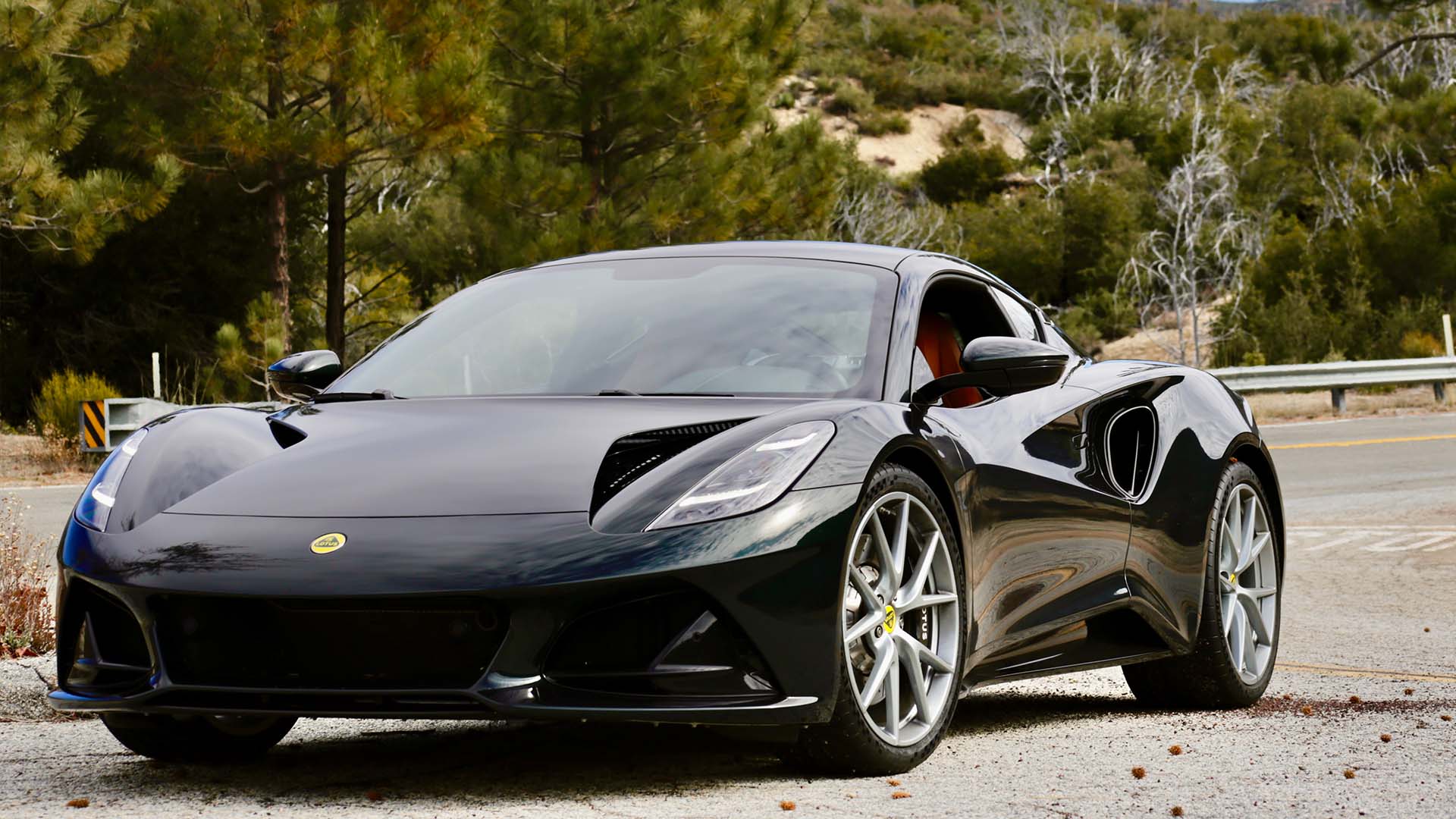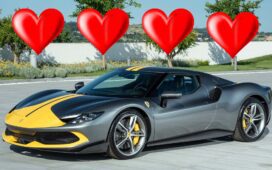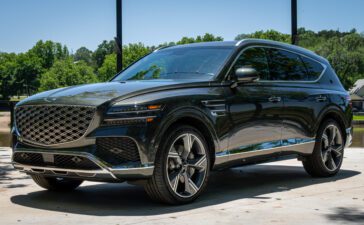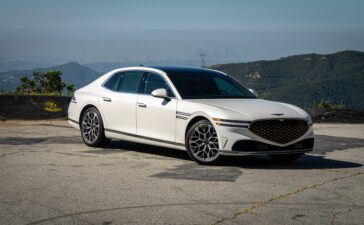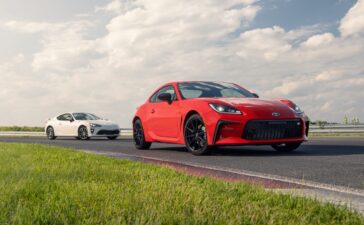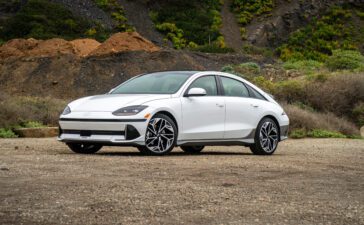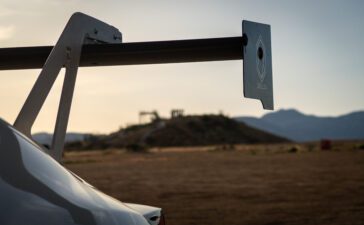Making the most of old technology usually takes the form of automakers making big profit margins on platforms that have been around for longer than usual. It’s not a bad strategy. Look at the previous-generation Lexus LX and GX; excellent trucks that barely changed over the better part of fifteen years. Or the W-body Chevy Lumina … Okay, bad example. However, legendary British sports car maker Lotus takes a completely different approach to this strategy with its latest mid-engine sports car, the Emira.
The UK brand does it by going against what every other sports car maker has grown a little too accustomed to: Instead of the Emira having electric power-assisted steering like everyone else these days—this side of McLaren, at least—this mighty midship has hydraulic-assisted power steering. It’s very old technology, yet it possesses far better characteristics, like improved communication, excellent weight, and so on, that make the driving experience quite special.
Hydraulic steering may be a little harder to amortize over time due to its higher cost, and it’s more of a pain to service, but it’s well worth it. In fact, when combined with the 2024 Lotus Emira First Edition’s other top qualities—a stiff and lightweight chassis, as well as a potent V6, standard six-speed manual transmission, and gorgeous sports car looks—it makes for an overall excellent package that anyone who considers themself a driving enthusiast would thoroughly dig. Here’s how it all comes together to not only be one of the best Lotus sports cars ever made but also a very refreshing option in a new car market that’s awash with portly curb weights, excessively long wheelbases, as well as bland, lifeless electric power steering.
Skip to section:
- Specs
- Design and tech
- Compared to Evora GT?
- Actually daily drivable?
- A great chassis
- A greater powertrain
- Conclusion
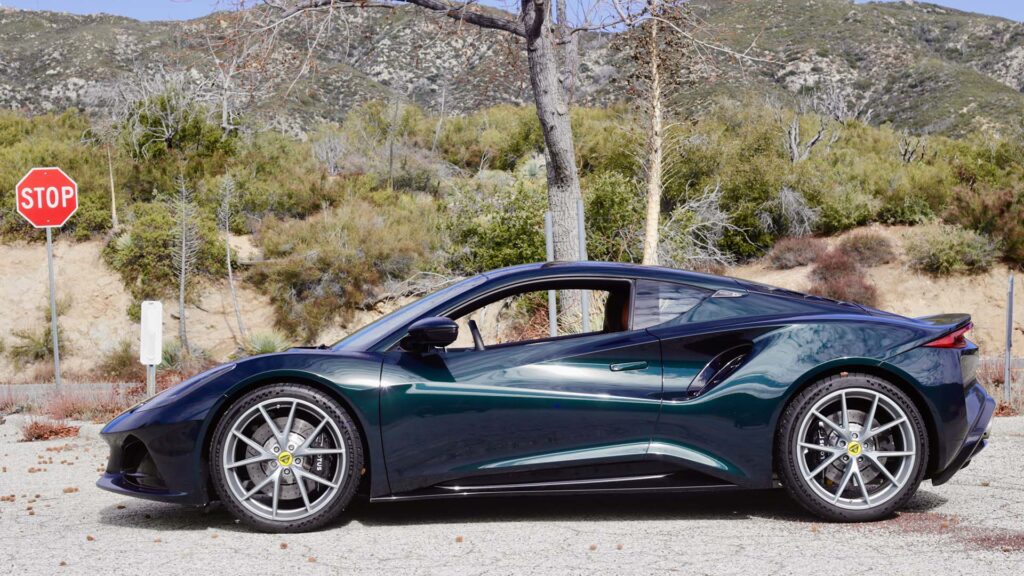
Price and specs
To hop in the 2024 Lotus Emira First Edition with a supercharged V6 behind its two seats, turn the key, and rip off down the road in a hilariously fun manner, it’ll require $104,500 to start. That’s no small sum of money, but then, it’s no small sum of car. Well, it’s dimensionally pretty small, but you know what I mean.
Bolt up this tester’s lightweight forged 20-inch wheels, and the price comes out to … well, just $1,000 more. Its Dark Verdant Green paint, tan leather interior, sports suspension, and manual gearbox are no additional charge, so the total works out to $105,500. Suppose you’re inclined to go for an automatic gearbox, that tacks on an additional $2,150. Save the manuals, as well as some cash: Pick the stick.
[Button id=”368″]
| Base price: | $104,500 |
| As-tested price: | $105,500 |
| Engine: | 3.5-liter supercharged V6 |
| Transmission: | 6-speed manual |
| Drivetrain: | rear-wheel drive |
| Power: | 400 horsepower @ 6,800 rpm |
| Torque: | 310 pound-feet @ 3,500 rpm |
| Redline: | 6,800 rpm |
| Weight: | 3,212 pounds |
| Zero-to-60 mph: | 4.2 seconds |
| ¼-mile: | 12.7 seconds @ 111 mph |
| MPG: | 17 city, 26 highway, 20 combined |
| Observed MPG: | 19.0 |
| Fuel Capacity: | 14.5 gallons |
Coming soon is a turbocharged four-cylinder from Mercedes-AMG bolted up in place of the supercharged V6, which’ll start a little less at $99,900; Acceleramota will report more on that at a later date. I’ve had the pleasure of revving out this mighty four in other vehicles, and it’s an absolute riot; choosing between the two powertrains will be a tough decision.
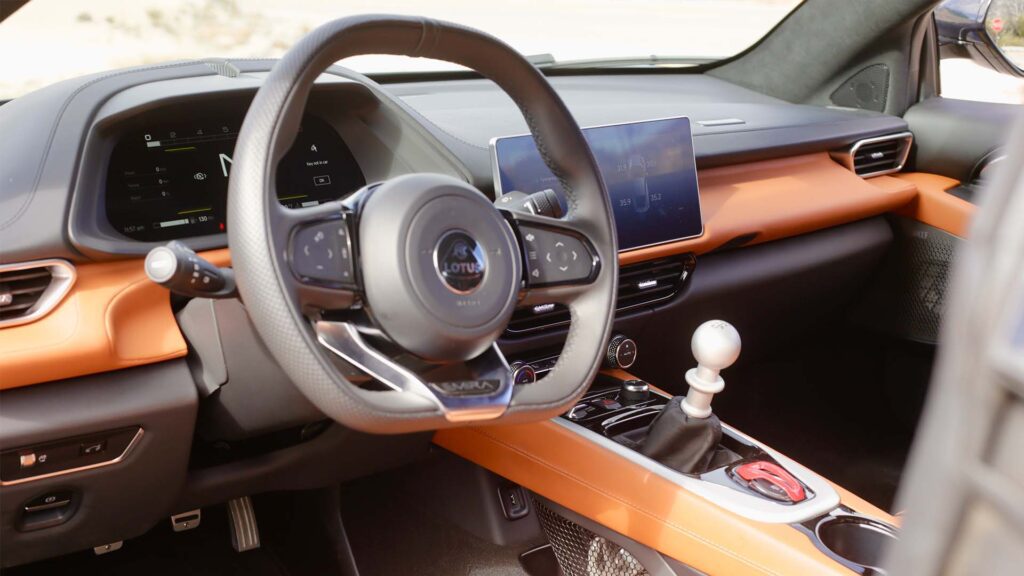
Design, interior, and infotainment
Let’s cut right to the chase: The Lotus Emira is simply beautiful. While the brand’s never been a stranger to penning striking design, this new two-seater slots nicely within its Greatest Hits alongside the Elan, Esprit, Esprit V8, and Elise.
The Emira’s short and wide stature is nicely adorned with intakes and venting cut into its bodywork, pronounced front fenders, wide hips, sharp headlights, and taut lines throughout. It’s got trim athleticism in spades and looks drop-dead gorgeous from every angle. Where the Evora looked ever-so-slightly awkward from a couple of angles, possibly due to being 2+2, the Emira simply can’t be faulted. Especially on my tester’s 20-inch silver wheels and paint that errs towards British Racing Green yet has more depth and faint metallic flake to it. It’s a beautiful take on this default-good color.
Inside is the same song, second verse. Where the Evora was a little more bare and focused (which I actually loved about it), the Emira is more geared towards luxurious everyday liveability. This is a good thing—less knocks against it parked next to a Porsche Cayman, and the world would be a better place if more people were inclined to daily drive high-end mid-engine sports cars. Giving it this plush interior extinguishes excuses not to.
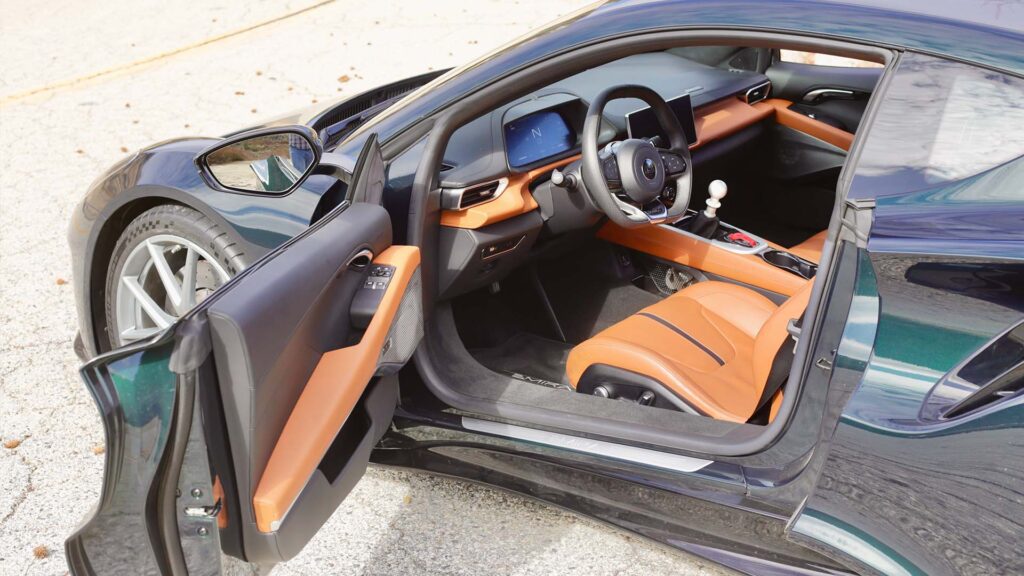

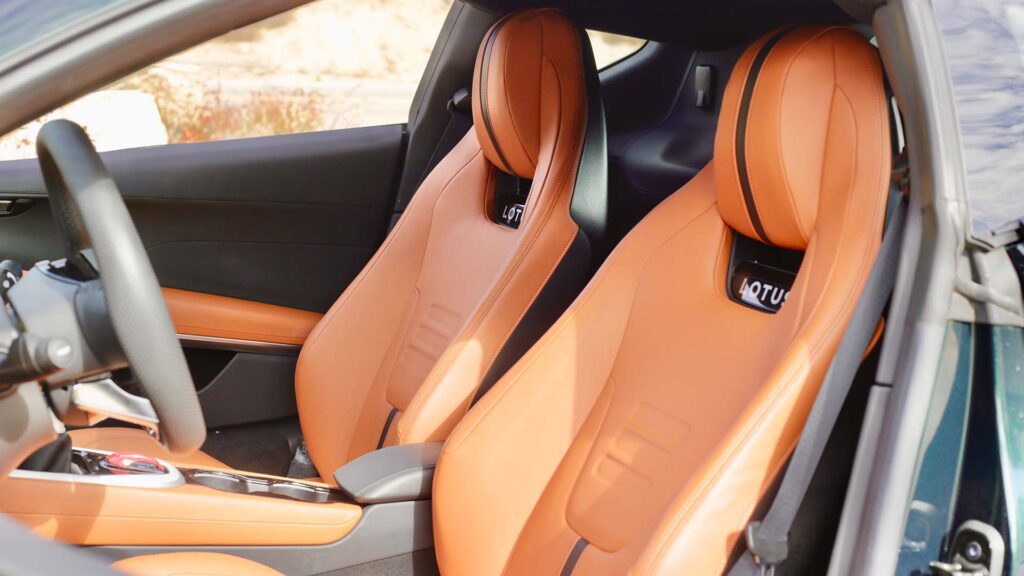
Speaking of plushness, much of the interior’s square footage is covered in supple Nappa leather and Alcantara, and the overall design is quite chic. It may also be a small two-door sports car, but it’s actually plenty bright and airy, making something like a Toyota GR Supra feel like solitary confinement by comparison. With this airiness comes an appreciable increase in spaciousness over the Evora, with plenty of head, leg, and shoulder room for my slim six-foot-three stature.
Seating-wise, I was initially a little disappointed that the Emira didn’t have the same near-race-level Sparco seats that the final iteration of the Evora GT possessed. But the 12-way power-adjustable buckets actually proved to be quite good: the driver’s seat was easy to slide in and out of, had great all-day comfort, and even held me in respectably well on fun roads. Win across the board.

Then, it possesses some select fine details that really upped the interior’s bespokeness like a good bit of the shift linkage that’s exposed behind some metallic mesh. I like to think that is Lotus’ way of paying tribute to the almighty, sacred manual gear change. It even lights up at night; how cool is that?
One aspect of the Emira’s interior that’s somewhat unchanged from the Evora is its cargo room. Like the Evora, there’s sadly no frunk to impress your friends or passers-by, but the trunk area could accommodate either a small piece of luggage or two or a small haul of weekly groceries. Just don’t travel too far if you’ve got ice cream in there—it sits next to one bank of cylinders and atop most of the exhaust system. Then, instead of the old Evora’s rear “seats” that were less roomy than an iron lung, there’s a cargo shelf that’s plenty commodious for daily haulings or some light luggage.

When it comes to infotainment, the Emira doesn’t have a whole lot going on, and that’s very much a good thing. The center 12.25-inch touchscreen has good feedback, a nice layout, and no lag, and it’s quite easy to navigate through. It’s equipped with Bluetooth, Apple CarPlay, and Android Auto, and the stereo system has great overall audio quality.
To split hairs, I had to re-pair my phone every morning to get Apple CarPlay working. But when the car’s own soundtrack is as wonderful as it is, I didn’t find myself as inclined to listen to music or podcasts as I’d normally be. Even while rolling along in mundane Los Angeles traffic.
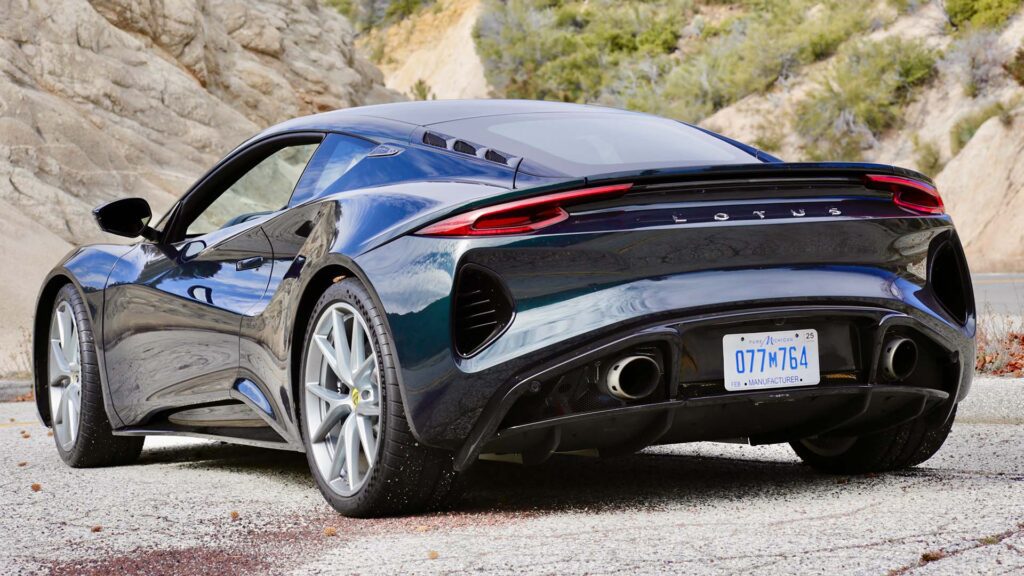
| What’s hot? | – Wonderful overall handling – Surpringly great ride quality around town – Brilliant hydraulic steering – Rioutous supercharged V6 – ‘Dem looks |
Versus the outgoing Evora GT
It’s important to point out that the Emira isn’t the full-on replacement for the Lotus Evora GT. As far as Evora vs. Emira goes, it’s the succeeding model. But as far as non-GT vs. GT goes, that’s like comparing the Porsche 718 Cayman GTS against the Cayman GT4—Both are well-regarded as massively fun mid-engine sports cars and their Lotus’ direct competitors. But they aren’t interchangeable in the Porsche trim hierarchy, nor are they meant for the exact same purpose. One’s more daily-friendly, whereas the other is more engineered for laps on track.
Though, after spending a week with the ravenous and ever-entertaining Evora GT two years back and now becoming well-acquainted with the Emira, I really hope there will be an Emira GT. Though, in light of some recent unfortunate news, the chances are slim.
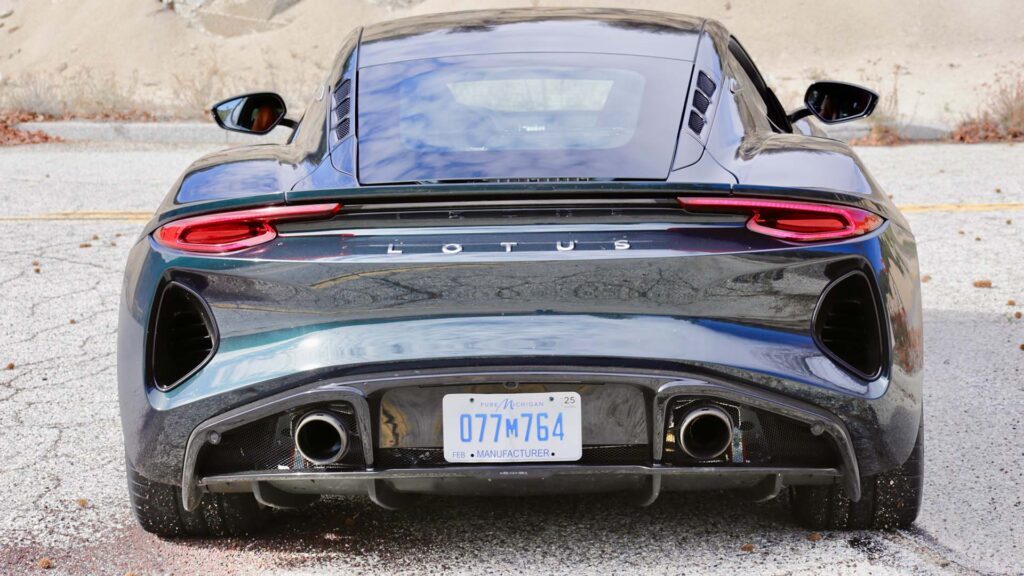
Well-natured around town and on the highway
Where the Lotus Evora GT’s suspension was surgical in its precision, the Emira is a bit more toned down and everyday friendly. This isn’t intended as an apples-to-apples comparison, but it’s important to point out for anyone fiending for something built by the British firm in the past couple of years. The Emira hits it out of the park with daily-ability compared to the former GT.
My favorite place to see how any car deals with crappy city roads is Los Angeles’ neighborhood of Silver Lake. Decades of yuppification have left its tarmac thoroughly brutalized by construction vehicles, with many stretches littered with tar patches that resemble a welding student’s first couple inches of MIG work. It’s a rough place to drive.
The Lotus Emira dealt with all of it shockingly well. From sharp and bumpy stuff to flat-out violent bits that’d make a trophy truck blush, I could feel the Emira’s conventionally damped compression and rebound work overtime to filter it all out. It’s still a sports car—it didn’t waft across the road like a Rolls. But for something sporting an enthusiast-focused chassis, low weight, and just 101 inches between its wheelbase, I was impressed. Who needs adaptive dampers when you’ve got low weight and a Lotus engineer’s legendary stamp of approval?

The same goes for its highway manners. Where the Evora GT would lightly dart around and tramline, the Emira felt more solid. It still tramlined ever so slightly here and there over particularly offensive SoCal highway asphalt, but it generally tracked forth with confidence, and that same nicely tuned compression and rebound gave it a very roadtrip-ready ride quality.
Here’s the thing: Lotus offers either what it calls a Sports or Touring suspension package for the Emira. The former is more focused on performance, whereas the latter is on the softer side. I had no qualms with Sports option ride over construction-equipment-beaten tarmac in the heart of Los Angeles gentrification. But for someone who is perhaps after even more comfort that bolsters daily-ability even further, I couldn’t fault them.
Then, when it came to noise, there was more of the wind and road variety than your average car while rolling along on the highway, but not to any annoying degree. Most folks would quickly check it off as something that goes with the territory in a little high-end sports car.

The best part: a chassis Chapman would love
But where the Lotus Emira truly shined was where Lotuses have always been tuned for: twisty fun roads.
Setting out up Southern California’s Angeles Crest Highway, I took it easy at first to bring its tires up to temperature. At a mildly enthusiastic clip through its picturesque sweepers, I couldn’t help but smile in excitement—if body motion was this flat, and grip was this unbothered, I couldn’t wait to bump up the pace.
Once its 245-front and 295-rear Michelin Pilot Sport Cup 2s felt ready, I dipped the throttle and went to work balancing out the Emira’s inputs with bigger and bigger values. First and foremost, and perhaps what truly separates this British sports car from its competition, is its steering, which is pure bliss. Past a few degrees, the ratio felt nearly 1:1 with the angle of the nose, so much texture transmitted through the wheel, and its weight loaded up perfectly through every flavor of corner.
Why more manufacturers don’t spend a teeny bit more coin to throw a good old-fashioned hydraulic steering rack in their prized sports cars is beyond me. But I’m quite thankful that Lotus still does.
Equally brilliant was the Emira’s suspension and chassis tuning. That same feeling of unwavering, sure-footed grip at modest speeds never ceased at much higher paces. Its aluminum extruded and bonded chassis, plus double-wishbone suspension under each wheel arch and 40/60 distribution of just 3,212 pounds, meant there was very minimal sway under the hardest lateral G force. Like any good mid-engine chassis, once I got into a corner-carving rhythm, I never wanted it to end.

It was such a wonderfully communicative experience as if I had a head-up display telling me every tenth of a percent change in weight balance across all four wheels. I felt so in tune with every little input. Traction control rarely intervened, too: This chassis is a little forgiving, but it was happy to reward well-balanced steering, acceleration, and braking inputs with shockingly high numbers on the speedometer.
The brakes were always up to the task of maintaining control and reigning you in. Behind its bright silver wheels live 14.5-inch front and 13.8-inch rear two-piece drilled rotors with four-piston AP Racing calipers, and they made for a brilliantly firm yet easy-to-modulate pedal. The pedal box itself is quite narrow, just like the Evora GT’s was, but the spacing makes for easy heel-toe downshifting. Overall, braking performance was quite good, though, after half an hour of hard use, they did start to exhibit some fade and vibration. Considering the Emira’s increased daily-friendly sports car appeal over the more focused Evora GT, this is easy to forgive.

The other best parts: an engine and transmission like no other these days
People may poke fun from time to time at the Evora’s, and now Emira’s, Toyota Camry-sourced 3.5-liter V6, but Lotus could’ve fooled me of its origins. A massive air-to-water-cooled Edelbrock supercharger sits atop its intake valves and helps boost horsepower and torque to 400 and 310, respectively, which push the little Emira to 60 mph in as little as 4.2 seconds.
Its soundtrack is a beautiful mix of baritone V6 growl and supercharger whine. The latter is the most audible with as little glass as possible interrupting the aural fun—thus, it’s definitely a windows-down-as-much-as-possible experience. This thing’s anything but Camry-like. The way the mighty 3.5 revs up and bounces off the 6,800 rpm limiter is quite intoxicating and sounds like Lotus went to town with its own bespoke drivetrain and internal components. Such as a lightweight flywheel and some lightweight valvetrain work. If not, massive props for making me think it did.
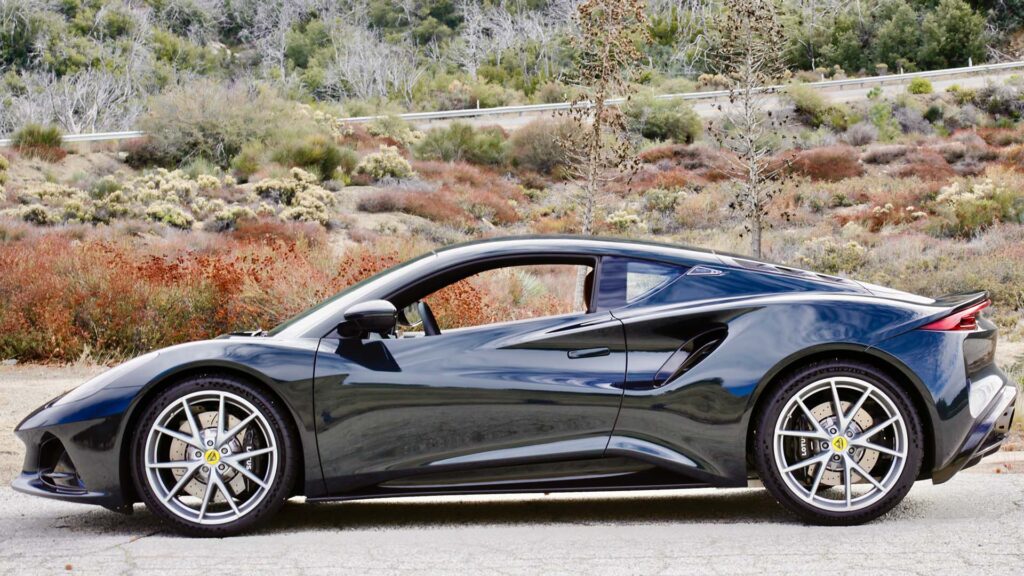
Power builds linearly, as is characteristic of any supercharged powerplant, and it just does so with all the gusto you’d expect after taking one look at that prominently placed blower. Nobody would call 400 horsepower lacking in the pursuit of shoving 3,212 pounds down the road. The mighty 3.5-liter was too fun to rev up and down, and its baritone growl turned into an all-out baritone scream above 5,000 rpm. It’s also a powerband that takes commitment, as you want to make sure there’s plenty of clear road ahead to get the full experience.
It’s an engine and transmission that’s more than happy to be driven lightly short-shifted around town, too, which really bolsters its daily-ability. There’s ample torque down low, and transmitting it via the Emira’s six-speed manual transmission is a hoot, just like listening to its delightful soundtrack during every up-and-downward sweep of the tach needle. Never gets old.
I should point out that traction control was a tad loose on cold tires around town. One time, while jabbing the throttle during a low-speed 45-degree left turn onto a 35 mph street, I had to feed the wheel some hilarious counter steer and make a bit of a scene. Upon further investigation (the kind that makes this job too fun at times), it turns out that the Emira’s ECU will allow a little slip to keep its occupants entertained but then follows up with a throttle cut. Neat.
A few months back, I did a brief drive in a very fresh, sub-thousand-mile Emira. Between it, the Evora GT, and this Emira with around 5,000 miles on the clock, the latter’s gear shift felt the best. I chalk it up to the bushings and linkage being more broken in, like a comfortable pair of leather shoes. There was very little play and a good amount of spring, and engagement felt quite positive in every gear. However, it was still a bit stiff and took a careful wrist to shift quickly. Treating it like a gated unit and shifting more methodically made for a much happier harmony between the output shaft and cog, though some folks may not dig that.

| What’s not? | – Shifter action not quite on par with the rest of the inputs – Steep price may be hard to justify against stiff competition – Uhhh, ummm… Geez, lack of cons? |
People better buy a lot of these things
The 2024 Lotus Emira First Edition is a very special sports car for this day and age. It one-ups everyone else by making the most of old steering technology. This blissful steering then combines with a wonderfully communicative chassis, manual gear shift, rousing supercharged engine, and overall brilliant driving dynamics to make it a true top-level driver’s car.
I’m really glad that Lotus is still at it and still makes stuff that’s quite nice to look at, to boot. The Emira may not be as hardcore as the old Evora GT was, but that just means a potential future Emira GT is worth crossing our fingers for. It costs a bit more than the more commonplace Porsche 718 Cayman GTS—in fact, it’s a considerable ten thousand or so dollars more. The Cayman’s steering may not quite stack up (though, I really want to find out for myself and report back), and it doesn’t mini McLaren, Ferrari, or other sharp, wedge-like mid-engine exotic. Though, that might not be enough to sway folks—only time will tell.
I’m glad the Emira is here and hope that by some stroke of luck, it sticks around for longer than its current reported prognosis. If you’re in the market, please take one for a spin and consider not only helping keep hydraulic-assisted power steering around, but also vivacious supercharger noises and brilliant, conventionally damped handling. We need to protect low-production sports cars like the Emira at all costs.

